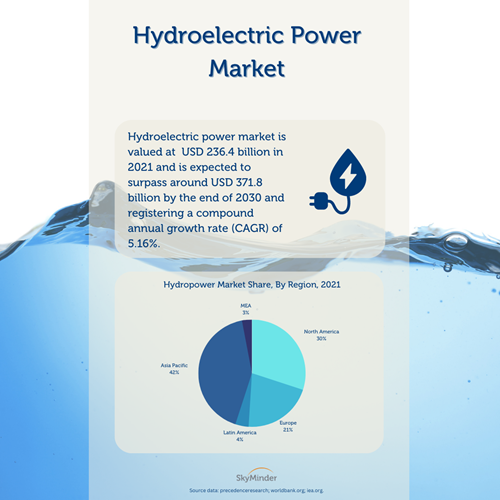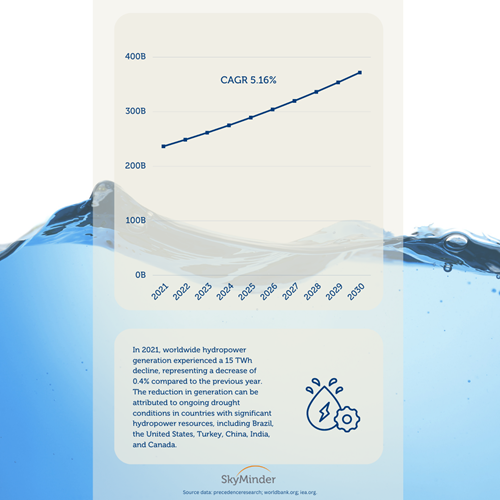Analysis and Studies - Studies
Global Market for Hydroelectric Power: an inisght
July 24th 2023
Hydroelectric energy, also known as hydropower, is a renewable form of energy that harnesses the power of flowing or falling water to generate electricity. It is one of the oldest and most widely used sources of renewable energy in the world.
Hydropower plants typically utilize the energy of moving water, such as rivers, dams, or waterfalls, to drive turbines connected to generators. The kinetic energy of the flowing or falling water rotates the turbine blades, converting the mechanical energy into electrical energy. The electricity produced by hydropower plants can be used to power homes, businesses, industries, and even entire cities.
One of the key advantages of hydroelectric energy is its renewability. Water is a naturally occurring resource that can be replenished through the water cycle, making hydropower a sustainable and clean energy source. It does not generate harmful emissions or greenhouse gases during operation, contributing to a reduction in air pollution and combating climate change.
A Market Insight
 The global hydroelectric power market was valued at USD 236.4 billion in 2021 and is projected to reach approximately USD 371.8 billion by the end of 2030, with a compound annual growth rate (CAGR) of 5.16%. However, in 2021, the worldwide hydropower generation witnessed a decrease of 0.4% compared to the previous year, experiencing a decline of 15 terawatt-hours (TWh). This reduction in generation can be attributed to persistent drought conditions in countries possessing significant hydropower resources, such as Brazil, the United States, Turkey, China, India, and Canada.
The global hydroelectric power market was valued at USD 236.4 billion in 2021 and is projected to reach approximately USD 371.8 billion by the end of 2030, with a compound annual growth rate (CAGR) of 5.16%. However, in 2021, the worldwide hydropower generation witnessed a decrease of 0.4% compared to the previous year, experiencing a decline of 15 terawatt-hours (TWh). This reduction in generation can be attributed to persistent drought conditions in countries possessing significant hydropower resources, such as Brazil, the United States, Turkey, China, India, and Canada.
The growing need for energy conservation has become a significant driving force behind the expansion of hydropower generation projects. This trend is expected to experience substantial growth due to the increasing demand for renewable energy sources. A large number of consumers worldwide are now opting for renewable energy in order to mitigate greenhouse gas emissions and address the pressing issue of climate change.
G overnments are actively participating in efforts to promote energy conservation and increase the production of renewable energy sources. This proactive involvement aims to address power shortages and meet the energy demands of a large global population. The presence of major players in the hydropower industry has facilitated the introduction of new technologies through extensive research and development programs. These initiatives are focused on enhancing the productivity of hydropower projects.
overnments are actively participating in efforts to promote energy conservation and increase the production of renewable energy sources. This proactive involvement aims to address power shortages and meet the energy demands of a large global population. The presence of major players in the hydropower industry has facilitated the introduction of new technologies through extensive research and development programs. These initiatives are focused on enhancing the productivity of hydropower projects.
In terms of geographical distribution, the Asia Pacific region dominated the hydropower market in 2021, holding a substantial market share of over 42%. This region's strong market position can be attributed to the comparatively low production costs of renewable energy sources and the significant reduction in overall infrastructure costs. The growing electricity demand in the region has been effectively met through the implementation of hydropower projects, further solidifying the Asia Pacific region as a prominent player in the global market.
However, there are also some considerations associated with hydroelectric energy. The construction of large dams and reservoirs can lead to environmental impacts such as habitat disruption, alteration of natural river flow, and potential displacement of communities. It is essential to carefully evaluate and manage these environmental and social aspects when planning and operating hydropower projects.
